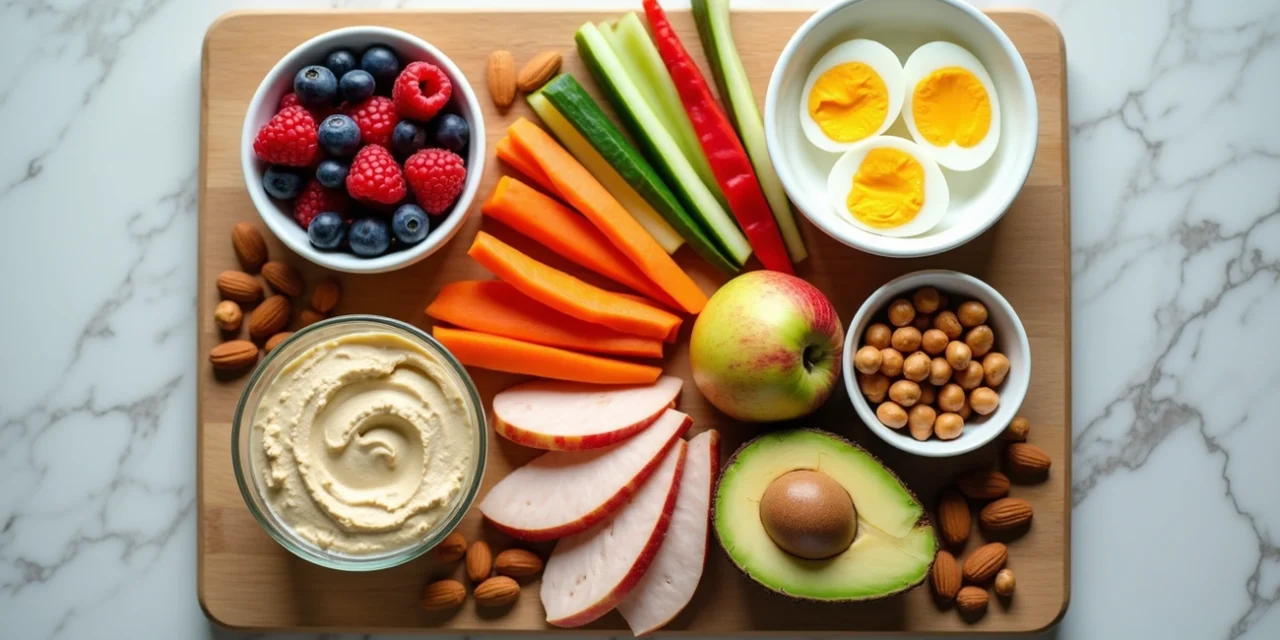Diabetics can enjoy delicious and healthy snacks that taste great. Smart snack choices help manage blood sugar levels and make diabetes management easier.
Snacks play a vital role in diabetes management. The right snacks keep energy levels stable between meals without causing blood sugar spikes. Diabetics need snacks that combine fiber-rich carbs, protein, and healthy fats in the right proportions. Many tasty alternatives exist instead of processed foods.
Hard-boiled eggs pack protein that helps you feel full longer. Yogurt paired with berries provides fiber and keeps blood sugar steady. Heart-healthy almonds reduce bad cholesterol and help regulate glucose metabolism. Blood sugar-friendly options like popcorn, avocado, and tuna make excellent snack choices. A 2023 study with Hispanic and Latino type 2 diabetes patients showed that avocado consumption link to lower HbA1c and fasting blood sugar.
Hard-Boiled Eggs
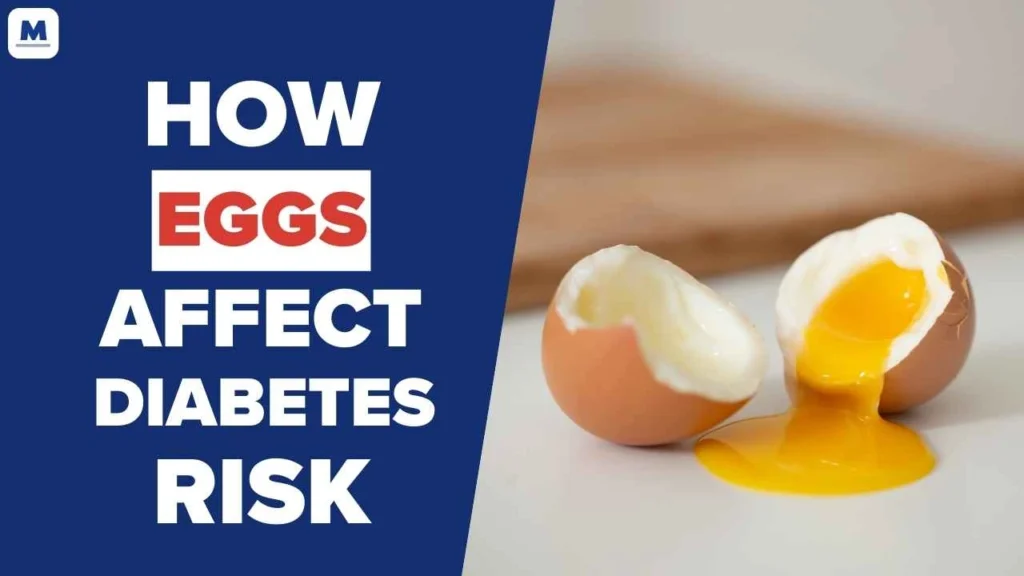
Hard-boiled eggs are one of the simplest and most nutritious snacks for people with diabetes. These protein-rich powerhouses need minimal prep time but give you maximum benefits to manage blood sugar.
Hard-Boiled Eggs Nutritional Profile
One large hard-boiled egg (50 grams) has 77 calories and packs impressive nutrients. Each egg gives you 6.3 grams of high-quality protein, 5.3 grams of total fat (mostly heart-healthy unsaturated fats), and only 0.6 grams of carbohydrates. This mix of nutrients makes eggs valuable to control blood sugar.
Hard-boiled eggs are a rich source of vitamins and minerals:
- Vitamin A: 6% of daily requirements
- Vitamin B2 (riboflavin): 15% of daily requirements
- Vitamin B12: 9% of daily requirements
- Selenium: 22% of daily requirements
- Phosphorus: 9% of daily requirements
Eggs also contain vital nutrients like vitamin D, choline, and antioxidants lutein and zeaxanthin that protect your eyes.
Why Hard-Boiled Eggs Are Great for Diabetics
Hard-boiled eggs make excellent snacks for diabetics. They have almost no carbs, so they won’t spike your blood sugar. The protein in eggs also slows down digestion, which helps prevent sudden hunger and keeps blood glucose steady.
Science backs up eggs’ role in diabetic diets. A newer study, published in 2018 by researchers found eating 12 eggs weekly didn’t harm body weight, cholesterol, or blood sugar levels in people with prediabetes or type 2 diabetes. In fact, another study showed people who ate one egg daily had better fasting blood glucose than those who ate egg substitutes.
Egg protein helps regulate blood sugar and improves glucose control. The protein takes longer to digest than carbs, which keeps you full and maintains steady energy between meals.
How to Prepare and Store Hard-Boiled Eggs
Making hard-boiled eggs is simple. Cool them in cold water or an ice bath after boiling to stop the cooking process. You can store them peeled or unpeeled.
Keep unpeeled eggs in an airtight container on the middle shelf of your refrigerator where temperature stays most stable. They’ll last up to 7 days.
For peeled eggs, use an airtight container with a damp paper towel to keep them moist. These stay fresh for up to 5 days.
Don’t leave hard-boiled eggs at room temperature longer than two hours as bacteria can grow. Throw away any eggs that smell odd, feel slimy, or look discolored.
Greek Yogurt with Berries

Greek yogurt and fresh berries make a creamy, satisfying snack that packs multiple nutritional benefits into one simple combination. The mix delivers great blood sugar control along with amazing flavor and texture.
Greek Yogurt with Berries Nutritional Profile
The straining process sets Greek yogurt apart from regular yogurt by removing liquid whey and lactose. You’ll get a thicker, creamier texture with remarkable nutritional benefits. Greek yogurt contains twice the protein of regular yogurt—8 grams per 100-gram serving compared to 4 grams in regular yogurt. This protein-rich profile has fewer carbohydrates than regular yogurt, which helps manage blood sugar levels better.
Greek yogurt provides calcium that strengthens bones and often includes added vitamin D through fortification. Berries have earned their status as “diabetes superfoods” because they deliver antioxidants and fiber with minimal carbohydrates. A half-cup of fresh blueberries contains just 42 calories and 11 grams of carbohydrates.
Why Greek Yogurt with Berries Helps Blood Sugar
This snack’s protein-fiber combination helps control blood glucose levels effectively. Dairy proteins boost insulin response and lower post-meal blood sugar levels in healthy people and those with type 2 diabetes.
The live probiotics found in many Greek yogurt products can reduce fasting blood sugar and hemoglobin A1C in people with type 2 diabetes. The combination creates a balanced snack that prevents blood sugar spikes—berry fiber slows down carbohydrate digestion while protein manages hunger.
Look for unsweetened yogurt options with live and active cultures. The best products contain 10 grams of sugar or less, and ideally less than 15 grams of total carbohydrates per serving.
How to Make Greek Yogurt with Berries
This diabetic-friendly snack comes together quickly:
- Start with 1 cup of plain, unsweetened Greek yogurt
- Top with ½ cup mixed berries (blueberries, strawberries, or raspberries)
- Optional: Add 2 tablespoons of chopped nuts (almonds or walnuts) that add crunch and healthy fats
A tablespoon of chia seeds or flax seeds adds extra fiber and omega-3 fatty acids. Frozen berries work just as well when fresh ones aren’t available.
You can make this snack ahead and keep it in the fridge for a quick option. Another idea is to spread Greek yogurt on parchment paper, add berries, and freeze for 3-4 hours before breaking into pieces.
The combination of protein-rich Greek yogurt and nutrient-dense berries creates a filling snack that keeps blood sugar levels stable. This makes it one of the best choices for diabetics who want both nutrition and satisfaction.
Almonds

Almonds rank among the best snacks diabetics can enjoy. These tiny powerhouses pack nutrition and convenience into one package. You’ll get impressive blood sugar benefits while satisfying hunger with their rich, nutty flavor.
Almonds Nutritional Profile
A standard serving of almonds (about 23 whole nuts or 1 ounce) packs quite a nutritional punch. Each serving gives you around 164 calories, 6 grams of protein, 14 grams of healthy fats, and 3.5 grams of fiber. The fats are mostly monounsaturated—the same heart-healthy kind you’ll find in olive oil.
These nuts stand out from other tree nuts because of their protein content. They’re loaded with essential nutrients like vitamin E and manganese. Diabetics should note that almonds pack plenty of magnesium—just one ounce gives you nearly 80 mg. That’s about 25% of what women need daily and almost 20% for men.
Why Almonds Are a Smart Snack for Diabetics
Studies show that almonds help keep blood sugar levels steady. They work especially well when you have diabetes. Research points out that eating almonds can lower post-meal glucose and insulin levels.
One study found that eating 2 ounces of almonds (roughly 45 nuts) helped lower fasting insulin and glucose levels. Another study showed that 20g of almonds eaten 30 minutes before meals helped control blood sugar better in people with higher-than-normal levels.
The magnesium in almonds plays a key role in glucose metabolism. This matters because high blood sugar makes diabetics lose more magnesium through urine.
Almonds boost heart health too—a big plus since diabetes raises heart disease risk. Their healthy fats help bring down LDL (“bad”) cholesterol levels.
How to Portion Almonds for Snacking
Almonds pack lots of nutrients but also calories. Watch your portions carefully. Stick to 1 ounce (about 23 almonds) to get the benefits without extra calories.
Here are some easy ways to avoid eating too many:
- Put your almonds in small containers or bags ahead of time
- Buy single-serving packages for easy snacking on the go
- Use a measuring cup instead of eating straight from the bag
Adding almonds to your daily routine is simple. Eat them plain between meals, toss them on salads, or mix them into yogurt for extra crunch and nutrition.
Pick unsalted varieties without added sugar, honey, or chocolate coating to get the most health benefits.
Veggies and Hummus
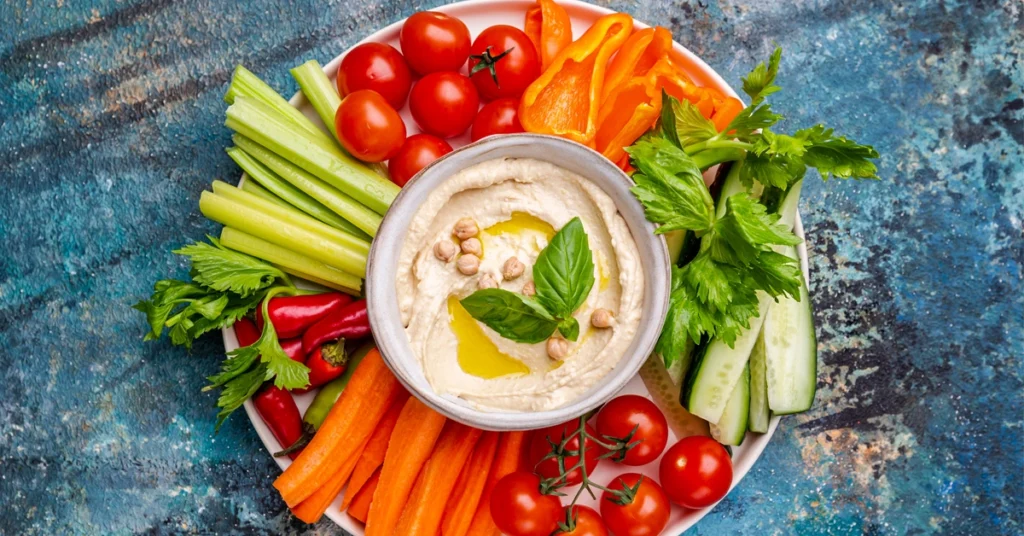
A delicious combo of colorful vegetables and creamy hummus makes a perfect snack that helps people with diabetes maintain steady blood sugar levels. This nutritious pair tastes great and provides amazing health benefits without causing sugar spikes.
Veggies and Hummus Nutritional Profile
The base of hummus comes from chickpeas mixed with tahini (sesame seed paste), olive oil, lemon juice, and garlic. A 28g (2 tablespoon) serving of hummus contains about 50 calories, 3g available carbohydrate, 1g dietary fiber, 2g protein, and 5g mostly unsaturated fat. Lower-fat versions still pack great nutrition with 239 calories, 9.3g protein, 11.3g carbs, and 16.4g fat per 100g serving.
Hummus gets its nutritional power from its ingredients. Chickpeas pack protein, fiber, resistant starch, and nutrients like riboflavin, niacin, thiamin, folate, potassium, and phosphorus. Tahini adds unsaturated fatty acids, antioxidant lignans, tocopherols, calcium, and phosphorus.
How Veggies and Hummus Support Blood Sugar Control
This snack combo works great for blood sugar management because hummus has a remarkably low glycemic index of about 15. White bread scores 100 on the GI scale. Studies show that blood glucose responses to hummus are four times lower than white bread, while maintaining normal insulin levels.
Several factors make this combination effective. Hummus contains soluble fibers that slow down digestion and make you feel fuller longer. Its protein content helps keep blood sugar steady. The healthy fats in hummus boost glucose metabolism.
A small 2020 study revealed that eating hummus as an afternoon snack lowered blood glucose levels and kept people feeling satisfied longer. Fresh vegetables add more fiber to slow down carb absorption.
Best Veggies to Pair with Hummus
Raw, colorful vegetables work perfectly with hummus. Carrots score high on the Nutrient Density Index with a very low GI, so they won’t spike blood sugar. Research shows carrots might help control type 2 diabetes through their vitamin C content.
Bell peppers in red, yellow, and green varieties deliver vitamins C, A, and B6—great for immune health and vision. Cucumber helps with hydration, blood pressure, and blood sugar control.
Celery packs flavonoids plus vitamins A and C that might prevent heart disease and regulate glucose levels. Radishes provide natural hydration and contain anti-diabetic compounds like glucosinolate and isothiocyanate that help manage blood sugar.
Cherry tomatoes, broccoli, and cauliflower make excellent choices too—they’re packed with nutrients and low in carbs.
Avocado
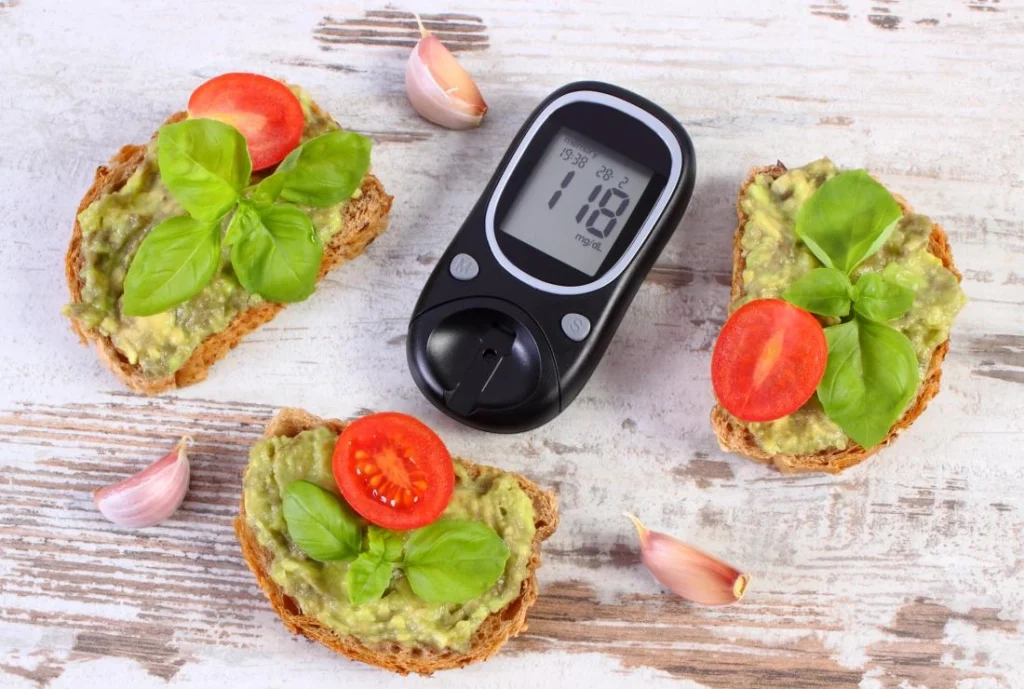
Avocados stand out from other fruits with their unique nutritional makeup that makes them a perfect snack if you have diabetes. This creamy, versatile fruit packs healthy fats, fiber, and essential nutrients that help maintain stable blood sugar levels.
Avocado Nutritional Profile
A medium avocado (approximately 7 ounces or 201 grams) packs 240 calories with an impressive nutrient mix. The fat content makes them special—you’ll get 22 grams of fat, where 15 grams are heart-healthy monounsaturated fats. Avocados rank among the highest-fat plant foods you can find.
These fruits are nowhere near other fruits in sugar content — with less than 1 gram per cup. You’ll also get about 10 grams of dietary fiber, which is 21% of what you need daily. The nutrient package includes potassium (21% of daily value), folate (41% of daily value), and magnesium (14% of daily value).
Why Avocado Is a Diabetic-Friendly Snack
Avocados make one of the best snacks for diabetics because they don’t spike blood sugar levels. A 2023 study with Hispanic and Latino people who had type 2 diabetes showed that eating avocado led to lower HbA1c and fasting blood glucose.
The magnesium and potassium in avocados are vital for diabetes management. Magnesium helps with glucose metabolism and insulin regulation, which improves glycemic control. Potassium supports heart function and helps nutrients move into cells.
People with type 2 diabetes who keep taking avocados might see HbA1c values about 7 mmol/mol lower than those who don’t eat them. The fruit’s benefits don’t stop there—research shows women who ate avocados daily reduced their belly fat over 12 weeks, which could lower insulin resistance risk.
Simple Avocado Snack Ideas
Adding avocados to your snacks can be easy:
- Slice them up with salt and pepper or a lemon squeeze
- Use mashed avocado as a spread on whole-grain toast
- Mix diced avocado into chicken or tuna salad for creaminess
- Add them to smoothies instead of dairy for smooth texture [234]
- Top your salads with avocado slices for healthy fats
Half a medium avocado works perfectly if you have diabetes and watch portions. This serving gives you about 12 grams of carbs and 6 grams of fiber, which fills you up without too many calories.
Apple with Peanut Butter

Apples and peanut butter make a perfect snack for diabetics. This combination offers balanced nutrients that help maintain steady blood sugar levels. The pairing gives quick energy and keeps you feeling full longer.
Apple with Peanut Butter Nutritional Profile
A medium apple (182 grams) contains about 95 calories, 25 grams of carbohydrates, and 4.4 grams of fiber. You’ll also get vitamins C, K, and potassium. Natural peanut butter (2 tablespoons or 32 grams) adds 188 calories, 7 grams of carbohydrates, 3 grams of fiber, 8 grams of protein, and 16 grams of mostly monounsaturated fat. Together, they provide 283 calories, 8 grams of protein, 16 grams of fat, and 7 grams of fiber. These numbers create the right balance to manage glucose levels.
Peanut butter’s micronutrients are vital for diabetics. You get manganese (29% of daily needs), niacin (22%), magnesium (13%), vitamin E (10%), phosphorus (10%), and potassium (7%). Research links peanut butter’s monounsaturated fats to better heart health. This benefit matters because diabetics have higher heart disease risks.
How This Combo Balances Blood Sugar
The pairing works through two different ways. Apple’s fiber creates a gel-like substance that slows down digestion. The soluble fiber helps prevent blood sugar spikes. Apples alone might raise glucose levels since they contain both glucose and fructose.
Peanut butter’s protein and fat content help stabilize blood sugar levels. A 2018 pilot study with 16 adults showed that adding 2 tablespoons of peanut butter to white bread and apple juice reduced glucose spikes by a lot compared to bread and juice alone. Peanut butter has a low glycemic index, so it won’t cause sudden blood sugar increases.
Tips for Choosing the Right Peanut Butter
The ingredient list should be your first checkpoint when buying peanut butter. The best options contain just peanuts and maybe some salt. Many store brands add sugars, hydrogenated oils, and preservatives that can harm your health.
Here’s what you need to know about additives:
- Low-fat versions usually have more sugar than regular peanut butter
- Natural peanut butter has 1 gram of sugar per serving while processed kinds have 3 grams
- Popular brands add 1-5% hydrogenated oils to stop separation
You can make peanut butter at home to control what goes in it. Just put 3 cups of roasted peanuts in a food processor, add salt if you want, and blend for 8-10 minutes until smooth.
Roasted Chickpeas

Diabetics can enjoy roasted chickpeas as a crunchy alternative to chips that won’t spike their blood sugar levels. This protein and fiber-rich snack stays fresh on the shelf and fits easily in your bag.
Roasted Chickpeas Nutritional Profile
A quarter-cup serving of roasted chickpeas packs 120-135 calories, 4-6g protein, and 4-5g fiber. You’ll get important minerals like iron (12% DV), magnesium (9% DV), and zinc (7% DV). The carbohydrates (15-20g per serving) work together with fiber to create a gentle effect on blood sugar [303].
Why Roasted Chickpeas Are a Great Crunchy Snack
Most people wouldn’t think of chickpeas as a snack, but roasting transforms them into a perfect crunchy treat. Diabetics will find these a better choice than processed snacks. The low glycemic index helps keep blood sugar stable. These little powerhouses contain resistant starch that slows down how your body absorbs carbs, plus they’re loaded with fiber.
How to Make Roasted Chickpeas at Home
You’ll need just a few ingredients to make roasted chickpeas:
- Rinse and dry canned or soaked chickpeas well
- Toss with olive oil and seasonings like cumin, chili powder, or paprika
- Spread on a baking sheet and roast at 300-400°F for 40-45 minutes, stirring occasionally until crispy
- Store in an airtight container—they’ll stay crunchy for several days
Mix up your flavors between savory and sweet to keep this healthy snack exciting.
Turkey Roll-Ups
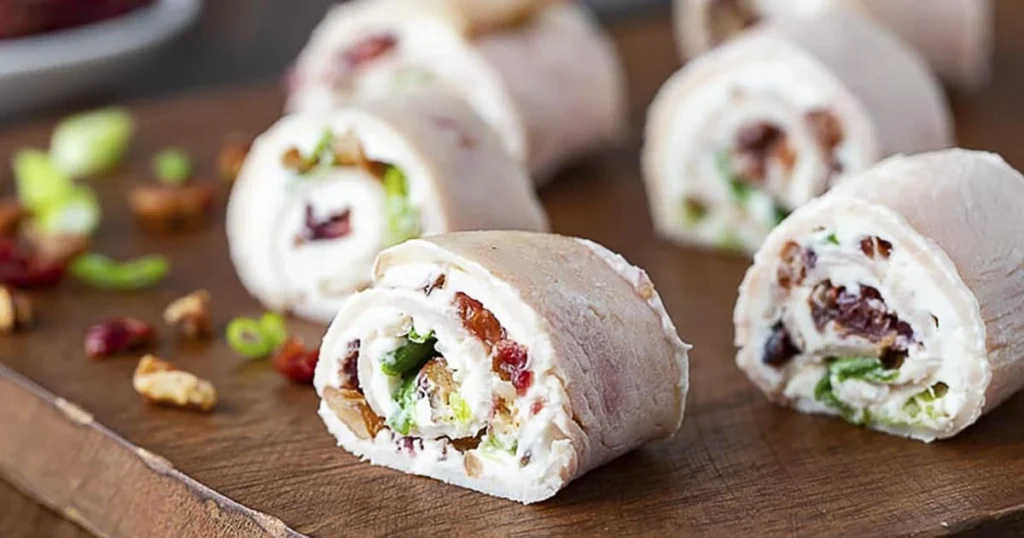
Turkey roll-ups make an excellent protein-rich snack for people with diabetes. These tasty wraps satisfy hunger without the carbs found in regular sandwiches.
Turkey Roll-Ups Nutritional Profile
The nutritional value of turkey roll-ups varies based on your choice of ingredients. A typical serving contains about 210 calories, 21g protein, 17g carbohydrates (with 13g fiber), and 8g fat. Different filling combinations can change the calorie count from 205 to 379 per serving, while protein ranges from 20-27g. The sugar content stays low at 1-4g per serving.
Why Turkey Roll-Ups Are Low-Carb and Filling
These healthy snacks work well for diabetics because their high protein content helps keep blood sugar stable. Turkey’s lean protein satisfies hunger without bread’s glucose spike. The wraps give steady energy and maintain stable blood sugar levels. The protein slows down digestion while the low carb content prevents glucose swings.
How to Make Turkey Roll-Ups
You can make these diabetes-friendly snacks quickly:
- Choose nitrate/nitrite-free turkey breast slices
- Add 1-2 tablespoons of cream cheese, hummus, or mashed avocado
- Layer non-starchy vegetables like cucumber, bell pepper strips, or spinach
- Roll everything tightly from the short end
- Let it chill 15-20 minutes before cutting if desired
The recipe becomes more interesting with herbs, pine nuts, or a sprinkle of dried cranberries.
Cottage Cheese with Fruit
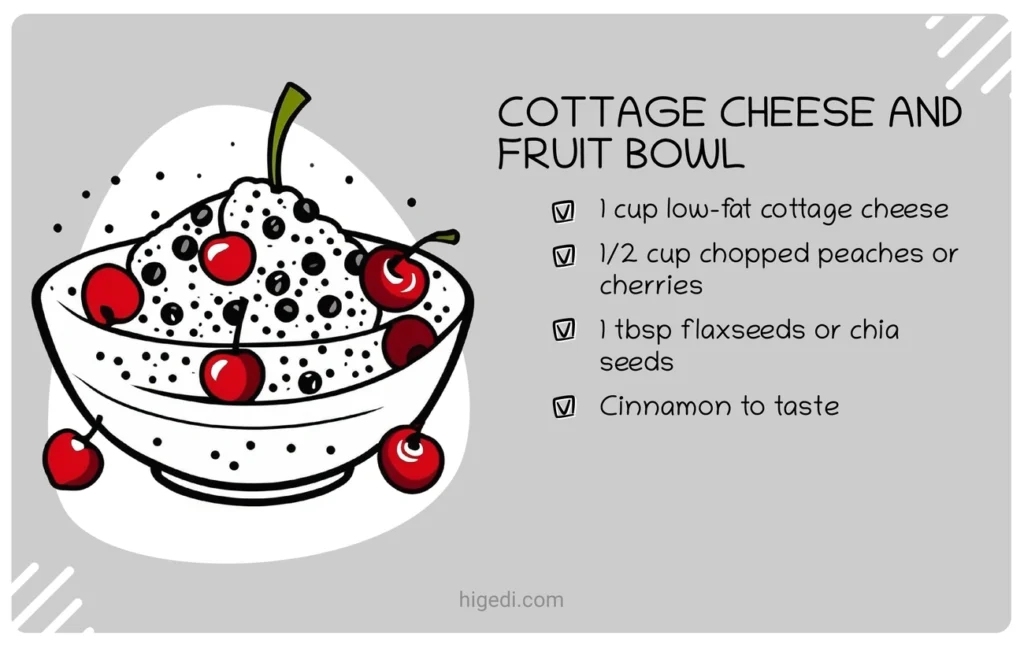
Cottage cheese stands out as a protein-rich snack that works great for diabetics. This dairy food tastes amazing with fruit and helps maintain healthy blood sugar levels.
Cottage Cheese Nutritional Profile
A half-cup serving of low-fat cottage cheese packs 13g of quality protein in just 90 calories. The carb content stays low at 4g per serving with 4g of sugar. It also delivers key nutrients like calcium (103mg), phosphorus (148mg), and selenium (14.6mcg). The casein protein in cottage cheese digests slowly, which makes it perfect to manage blood sugar levels.
How Cottage Cheese Helps Manage Blood Sugar
The low carb content in plain cottage cheese makes it a smart choice to monitor blood glucose. The high protein content helps slow down digestion and prevents sudden blood sugar changes. Studies show that protein stabilizes blood sugar levels, especially when you have foods containing carbs. Diabetics can enjoy cottage cheese’s dairy benefits without worrying about their glucose levels.
Best Fruits to Pair with Cottage Cheese
Berries make the best companions for cottage cheese if you have diabetes. Fresh strawberries, blueberries, blackberries, and raspberries pack antioxidants that boost brain health. You can also try peaches, kiwi, melon pieces, and pomegranate seeds. Stay away from pre-packaged cottage cheese with fruit in syrup since it contains extra sugar. Mix your own combinations at home – a half cup of cottage cheese with half cup of chopped strawberries has just 7.5g sugar.
Trail Mix
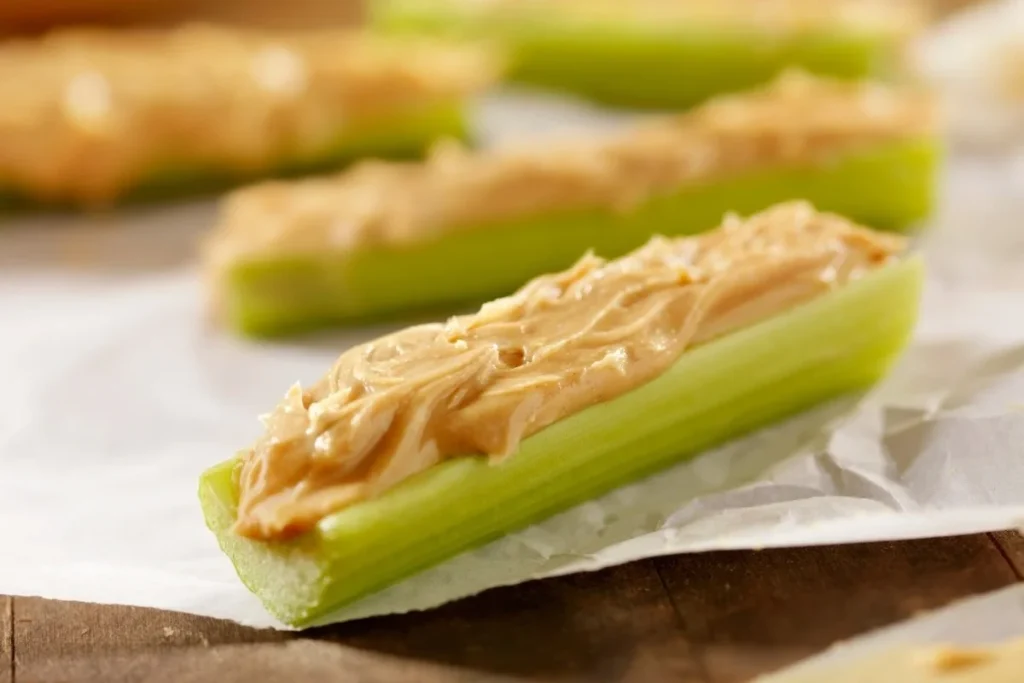
Trail mix is a versatile snack that people with diabetes can customize to meet their nutritional needs. It provides a satisfying crunch and fits well into a diabetic diet.
Trail Mix Nutritional Profile
A good trail mix combines nuts, seeds, dried fruits, and sometimes whole grains to create balanced nutrition. Each serving (1/4 cup) packs 150-175 calories, 8-14g healthy fats, 4-6g protein, and 9-15g carbohydrates. This mix helps your blood sugar stay stable after eating. You’ll get important minerals like magnesium, which plays a vital part in insulin action and glucose metabolism. The fiber content ranges from 2-4g per serving and supports your digestive health and blood sugar control.
How to Choose or Make Diabetic-Friendly Trail Mix
The best trail mixes use unsalted nuts and seeds such as almonds, walnuts, peanuts, and pumpkin seeds. These ingredients help control blood sugar through their magnesium content. When it comes to dried fruit, look for options without added sugars and watch your portions. Keep dried fruit amounts small since they contain concentrated sugars. Whole-grain cereals with minimal added sugars add complex carbohydrates. You can also make your own mix using unsweetened coconut chips, low-carb chocolate chips, and various nuts.
Portion Control Tips for Trail Mix
Trail mix packs a lot of calories in a small amount, so portion control matters. Keep your servings between 1/4 to 1/2 cup. Use measuring cups or divide your mix into small containers to avoid eating too much. Making individual serving bags works great. An airtight container in your fridge keeps the mix fresh for up to six months.
Edamame
Diabetics can benefit from adding young soybeans called edamame to their snack options. These beans pack great nutrition and barely affect blood glucose levels.
Edamame Nutritional Profile
A half-cup serving of edamame contains only 94 calories but delivers amazing nutrition. You get 7g carbohydrates, 4g fiber, 9g protein, and 4g fat. These beans have no cholesterol, contain no gluten, and give you important minerals like iron, calcium, magnesium, and potassium. The protein in edamame provides all nine essential amino acids your body needs.
Why Edamame Is a Protein-Packed Snack for Diabetics
The glycemic index of edamame ranks very low at 15-20, lower than most legumes. This makes these beans perfect to keep your blood sugar steady. The mix of protein, fiber, and healthy fats helps slow down digestion and stops glucose spikes. Edamame has fewer carbs than other beans, which helps diabetics control their blood glucose better.
How to Prepare Edamame
You can cook fresh or frozen edamame in several ways:
- Steam or boil pods in lightly salted water for 5-10 minutes
- Roast shelled edamame with spices for a crunchy alternative
- Add to salads, stir-fries, or grain bowls for extra protein
Try air-frying them with chili lime seasoning or enjoy them with a simple pinch of salt.
Peanut Butter Celery Sticks
A simple celery stick becomes a powerful diabetic snack when you add creamy peanut butter. This combination creates the perfect balance of nutrients to support steady glucose levels.
Peanut Butter Celery Sticks Nutritional Profile
This dynamic duo packs impressive nutrition. Celery sticks contain just 14.1 calories per cup with minimal carbohydrates (3g) and beneficial fiber (1.6g). A tablespoon of peanut butter adds 94.4 calories, 3.8g protein, 8g of mostly unsaturated fat, and 3.5g carbohydrates with 1.1g fiber. Together they create a nutrient-rich snack that delivers niacin (15% DV), manganese (13% DV), copper (11% DV), and valuable amounts of vitamin B6, phosphorus, zinc, vitamin E, and folate.
Why This Combo Works for Blood Sugar
Peanut butter’s exceptionally low glycemic index of 14 makes it one of the best choices to prevent blood glucose spikes. The protein and healthy fats slow down carbohydrate digestion, which keeps blood sugar levels steadier. Celery adds beneficial antioxidants and flavonoids that support glucose metabolism. The magnesium in peanut butter helps insulin function better – something many type 2 diabetics need more of.
Tips for Making It a Go-To Snack
You should stick to 1-2 tablespoons of peanut butter per serving. Choose 100% natural peanut butter without added sugars or hydrogenated oils. You can add raisins occasionally for variety, but watch the added sugar. This satisfying combination makes a perfect between-meal snack that keeps you full without disrupting your glucose levels.
Conclusion
Smart snack choices are a vital part of managing diabetes. The 12 diabetic-friendly options in this piece share traits that make them great for blood sugar control. These snacks combine protein, fiber, and healthy fats – a perfect mix to keep glucose levels steady between meals.
High-protein options like hard-boiled eggs, almonds, and turkey roll-ups help slow digestion and prevent sudden hunger. Fiber-rich snacks such as veggies with hummus and roasted chickpeas provide nutrients without affecting blood sugar levels.
Avocados and Greek yogurt with berries are great choices that do more than control blood sugar. They support heart health and pack essential vitamins and minerals. These snacks taste great and work well in different combinations.
You need to watch portions even with these diabetes-friendly options. Measuring out trail mix or almonds ahead of time helps avoid overeating. Many of these snacks can be prepared in advance to make healthy eating easier.
These alternatives show that diabetes-friendly food can be tasty and satisfying. Each option helps manage hunger while keeping blood glucose stable. Adding these snacks to your daily routine helps avoid energy crashes and mood swings from blood sugar spikes.
Smart snacking is a key part of complete diabetes management. People with diabetes can enjoy satisfying treats between meals by choosing foods with protein, fiber, and healthy fats. This helps keep blood sugar levels steady throughout the day.
FAQs
Q1. What are some snacks that won’t raise blood sugar levels for diabetics? Some excellent snack options that won’t spike blood sugar include hard-boiled eggs, almonds, avocado slices, and veggies with hummus. These foods are low in carbohydrates and high in protein, fiber, and healthy fats, which help maintain stable blood glucose levels.
Q2. Are there any “junk food” alternatives that diabetics can enjoy? While traditional junk food is not recommended, diabetics can enjoy healthier alternatives like roasted chickpeas, air-popped popcorn, or homemade trail mix with nuts and a small amount of dried fruit. These options provide satisfying crunch and flavor without causing significant blood sugar spikes.
Q3. Is popcorn a suitable snack for people with diabetes? Yes, air-popped popcorn can be a good snack choice for diabetics when consumed in moderation. It’s low in calories and provides fiber, which helps slow down digestion and prevent rapid blood sugar increases. Just be mindful of portion sizes and avoid adding excessive butter or salt.
Q4. Can diabetics safely consume cottage cheese as a snack? Cottage cheese is an excellent snack option for diabetics. It’s high in protein and low in carbohydrates, which helps maintain stable blood sugar levels. Pairing it with fresh berries or other low-glycemic fruits can create a balanced and satisfying snack.
Q5. What are some quick and easy diabetic-friendly snack ideas? Some quick and easy diabetic-friendly snacks include Greek yogurt with berries, apple slices with peanut butter, turkey roll-ups, and peanut butter celery sticks. These options combine protein, fiber, and healthy fats to help manage blood sugar levels while providing essential nutrients.

